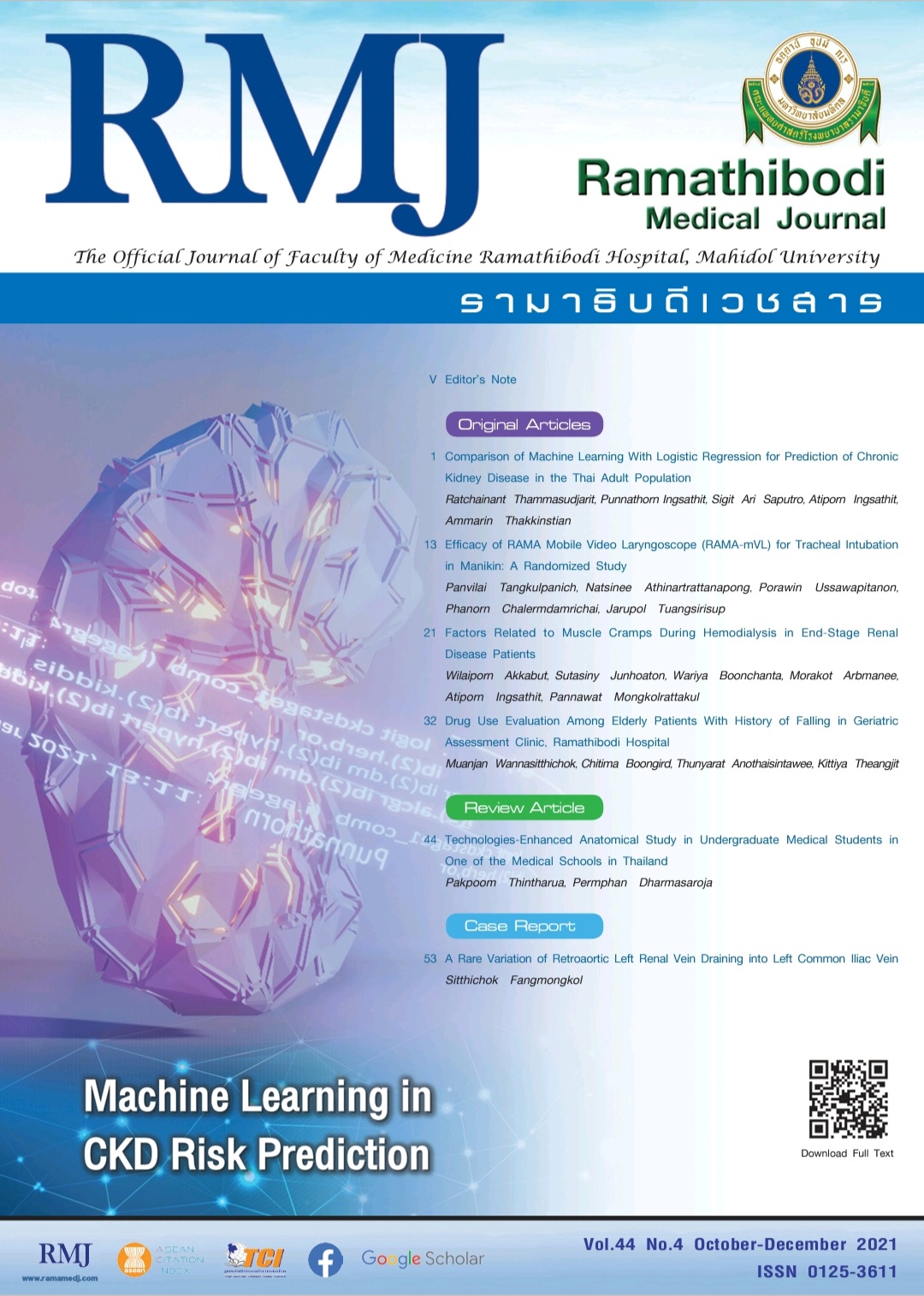Technologies-Enhanced Anatomical Study in Undergraduate Medical Students in One of the Medical Schools in Thailand
DOI:
https://doi.org/10.33165/rmj.2021.44.4.250876Keywords:
Anatomy, Medical education, Computer-based learning (CBL), Traditional cadaveric dissectionAbstract
Anatomy is an essential preclinical subject of undergraduate medical education. The traditional practical studies on cadavers are widely used in medical schools. It enhances active and deep learning, preparing students for clinical practice. However, the high costs, the time-consuming, and the health problems from chemical hazards, to which the staff exposed are considered. Computer-based learning (CBL) technologies can increase the efficiency of students in understanding anatomy. This review provides an overview of CBL technologies such as Anatomage table 7.0, zSpace, Complete Anatomy app, and 4D Interactive Anatomy that prepare Ramathibodi medical students for enhanced anatomical understanding and self-learning. The integration methods between traditional cadaveric dissection and the CBL in the curriculum can enhance the classroom experience, student engagement, learning, retention, and improvement of Ramathibodi medical student’s knowledge in anatomy.
References
Hirt B, Shiozawa T. Clinical anatomy as a modern concept for 21st century teaching, postgraduate education, and research. Kitasato Med J. 2013;43:99-103.
Kurt E, Yurdakul SE, Ataç A. An overview of the technologies used for anatomy education in terms of medical history. Procedia-Social and Behavioral Sciences. 2013;103:109-115. doi:10.1016/j.sbspro.2013.10.314
Karunathilake I. Technology enhanced learning with limited resources-transforming limitations into advantages. South-East Asian J Med Educ. 2017;11(1):1-2. doi:10.4038/seajme.v11i1.1
Winkelmann A, Güldner FH. Cadavers as teachers: the dissecting room experience in Thailand. BMJ. 2004;329(7480):1455-1457. doi:10.1136/bmj.329.7480.1455
Estai M, Bunt S. Best teaching practices in anatomy education: a critical review. Ann Anat. 2016;208:151-157. doi:10.1016/j.aanat.2016.02.010
Grizioti M, Kynigos C. Computer-Based Learning, Computational Thinking, and Constructionist Approaches. In: Tatnall A, ed. Encyclopedia of Education and Information Technologies. Springer; 2020. doi:10.1007/978-3-319-60013-0_75-1
Anatomage. 3D Anatomy & Physiology Visualization and Simulation with Table 7. Accessed November 12, 2021. https://www.anatomage.com/table7/
Allen MA, Kirkpatrick N, Agosto ER. Anatomage Table 6. J Electron Resour Med Libr. 2019;16(2):59-66. doi:10.1080/15424065.2019.1638866
Taoum A, Sadqi R, Zidi M, d’Anglemont de Tassigny A, Megdiche K, Ngote N. On the use of anatomage table as diagnostic tool. Int J Biol Biomed Eng. 2019;13:20-25.
Baratz G, Wilson-Delfosse AL, Singelyn BM, et al. Evaluating the anatomage table compared to cadaveric dissection as a learning modality for gross anatomy. Med Sci Educ. 2019;29(2):499-506. doi:10.1007/s40670-019-00719-z
Anand MK, Singel T. A comparative study of learning with “anatomage” virtual dissection table versus traditional dissection method in neuroanatomy. Ind J Clin Anat Physiol. 2017;4(2):177-180. doi:10.18231/2394-2126.2017.0044
zSpace. Technology. Accessed November 12, 2021. https://zspace.com/technology/
Sugimoto M. Augmented tangibility surgical navigation using spatial interactive 3-D hologram zSpace with OsiriX and bio-texture 3-D organ modeling. Paper presented at: 2015 International Conference on Computer Application Technologies; August 31 - September 2, 2015; Matsue, Japan; 2015:189-194. doi:10.1109/CCATS.2015.53
Saalfeld P, Schmeier A, D'Hanis W, Rothkötter H-J, Preim B. Student and Teacher Meet in a Shared Virtual Reality: A one-on-one Tutoring System for Anatomy Education. arXiv. Published November 17, 2020. Accessed November 12, 2021. https://arxiv.org/pdf/2011.07926.pdf
Motsinger SK. Complete anatomy. J Med Libr Assoc. 2020;108(1):155-57. doi:10.5195/jmla.2020.853
3D4Medical. Complete Anatomy 2021. Accessed November 12, 2021. https://3d4medical.com/
4D Interactive Anatomy. 4D Interactive Anatomy, As Good As Being There. Accessed November 12, 2021. https://www.4danatomy.com/
4D Interactive Anatomy. Dorsal lateral view: deltoid muscle. Accessed November 12, 2021. https://www.4danatomy.com/viewer/92/shoulder-left/labels/show/239?labels=239-598
Zibis A, Mitrousias V, Varitimidis S, Raoulis V, Fyllos A, Arvanitis D. Musculoskeletal anatomy: evaluation and comparison of common teaching and learning modalities. Sci Rep. 2021;11(1):1517. doi:10.1038/s41598-020-80860-7
Turney BW. Anatomy in a modern medical curriculum. Ann R Coll Surg Engl. 2007;89(2):104-107. doi:10.1308/003588407X168244
Sharma N, Doherty I, Dong C. Adaptive learning in medical education: the final piece of technology enhanced learning? Ulster Med J. 2017;86(3):198-200.
Mitrousias V, Varitimidis SE, Hantes ME, Malizos KN, Arvanitis DL, Zibis AH. Anatomy learning from prosected cadaveric specimens versus three-dimensional software: a comparative study of upper limb anatomy. Ann Anat. 2018;218:156-164. doi:10.1016/j.aanat.2018.02.015
Moro C, Štromberga Z, Raikos A, Stirling A. The effectiveness of virtual and augmented reality in health sciences and medical anatomy. Anat Sci Educ. 2017;10(6):549-559. doi:10.1002/ase.1696
Houser JJ, Kondrashov P. Gross anatomy education today: the integration of traditional and innovative methodologies. Mo Med. 2018;115(1):61-65.
Singh R, Tubbs RS, Gupta K, Singh M, Jones DG, Kumar R. Is the decline of human anatomy hazardous to medical education/profession?--a review. Surg Radiol Anat. 2015;37(10):1257-1265. doi:10.1007/s00276-015-1507-7
Simpson D, Marcdante K, Souza KH, Anderson A, Holmboe E. Job roles of the 2025 medical educator. J Grad Med Educ. 2018;10(3):243-246. doi:10.4300/JGME-D-18-00253.1
Chang C-Y, Hwang G-J. Trends in smartphone-supported medical education: a review of journal publications from 2007 to 2016. Knowledge Management & E-Learning. 2018;10(4):389-407. doi:10.34105/j.kmel.2018.10.024
Zargaran A, Turki MA, Bhaskar J, Spiers HVM, Zargaran D. The role of technology in anatomy teaching: striking the right balance. Adv Med Educ Pract. 2020;11:259-266. doi:10.2147/AMEP.S240150
Iwanaga J, Loukas M, Dumont AS, Tubbs RS. A review of anatomy education during and after the COVID‐19 pandemic: revisiting traditional and modern methods to achieve future innovation. Clin Anat. 2021;34(1):108-114. doi:10.1002/ca.23655

















